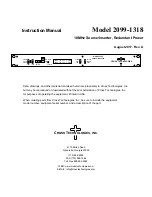
TMS320C6474
SPRS552F – OCTOBER 2008 – REVISED JULY 2010
www.ti.com
7.7
Reset Controller
The reset controller detects the different type of resets supported on the device and manages the
distribution of those resets throughout the device.
The C6474 device has several types of resets: power-on reset, warm reset, system reset, and CPU reset.
Table 7-18
explains further the types of reset, the reset initiator, and the effects of each reset on the chip.
Table 7-18. Reset Types
TYPE
INITIATOR
EFFECT(S)
Power-on Reset
POR pin
Resets the entire chip including the test and emulation logic.
Warm Reset
XWRST pin
Resets everything except for the test and emulation logic PLL2, AIF, and FSYNC. Emulation
stays alive during warm reset.
System Reset
Emulator
A system reset maintains memory contents and does not reset the test and emulation
Serial RapidIO
circuitry. The device configuration pins are also not re-latched and the state of the
peripherals (enabled/disabled) are also not affected.
CPU Local Reset
Watchdog Timer
CPU local reset.
7.7.1
Power-on Reset (POR Pin)
Power-on Reset is a special reset needed when powering on the DSP. The device is globally reset
through the assertion of the active-low Power-on Reset (POR) input. The power-on reset is intended to be
asserted to the device while the system power supplies are ramped.
For power-on reset, the main PLL Controller comes up in bypass and the PLL is not enabled. Other resets
do not affect the state of the PLL or the dividers in the PLL Controller. For the secondary PLL Controller,
this is different as the PLL is enabled and clocking always when POR is not asserted.
The following sequence must be followed during a power-on reset.
1. Wait for all power supplies to reach normal operating conditions while keeping the POR pin asserted
(driven low). While POR is asserted, all pins except RESETSTAT will be set to high-impedance. After
the POR pin is de-asserted (driven high), all Z group pins, low group pins, and high group pins are set
to their reset state and will remain at their reset state until otherwise configured by their respective
peripheral. All peripherals that are power managed, are disabled after a Power-on Reset and must be
enabled through the Device State Control registers (for more details, see
Section 3.2
, Peripheral
Selection After Device Reset.
2. Clocks are reset, and they are propagated throughout the chip to reset any logic that was using reset
synchronously. All logic is now reset and RESETSTAT will be driven low indicating that the device is in
reset.
3. POR must be held active until all supplies on the board are stable then for at least an additional 100
m
s.
4. The POR pin can now be de-asserted. Reset sampled pin values are latched at this point. PLL2 is
taken out of reset and begins its locking sequence, and all power-on device initialization also begins.
5. After device initialization is complete, the RESETSTAT pin is de-asserted (driven high). By this time,
PLL2 has already completed its locking sequence and is outputting a valid clock. The system clocks of
both PLL controllers are allowed to finish their current cycles and then paused for 10 cycles of their
respective system reference clocks. After the pause, the system clocks are restarted at their default
divide by settings.
6. The device is now out of reset and device execution begins as dictated by the selected boot mode.
112
Peripheral Information and Electrical Specifications
Copyright © 2008–2010, Texas Instruments Incorporated
Submit Documentation Feedback
Product Folder Link(s) :
TMS320C6474
Summary of Contents for TMS320C6474
Page 209: ...PACKAGE OPTION ADDENDUM www ti com 25 Sep 2010 Addendum Page 2 ...
Page 210: ......
Page 211: ......
Page 212: ......
















































